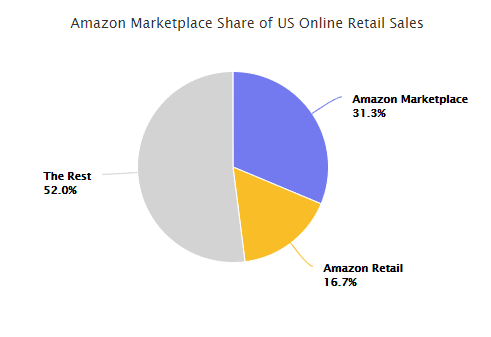Amazon and the Ecommerce Marketplace
Marketplace Pulse is one of the leading e-commerce intelligence and data firms in the market. In fact, no one collects more data on e-commerce marketplaces. Their 2018 Marketplaces: Year In Review is a worthwhile read. What are e-commerce marketplaces? A marketplace is simply an environment where buyers and sellers transact. It neither buys nor sells goods; it simply provides a venue for the transaction. Revenue is generated by collecting two kinds of fees: (1) transaction fees, and (2) fees for services to enable buyers and sellers to find each other more easily.
Amazon is dominating in the race to build the best marketplace, and it isn’t even close. This is probably the single largest contributor to its dominance going forward in e-commerce. Amazon has quietly steered its business model away from that of a traditional retailer into a marketplace. In fact, Amazon Marketplace is now 33% of all online retail sales in the US. It is one thing to silently build the largest segment of Amazon, but it’s another to surreptitiously build the largest business in all of online commerce beneath the feet of 300 million unwitting Americans. This move was highly strategic.
Digiday, a blog and media platform covering the business of online publishing and brands, published the Retailer’s Guide to Amazon, which concisely breaks down the basic workings of Amazon. If you want to sell products on Amazon, you have two ways to do it:
Amazon Vendor Central (“AVC”): In this case, you would be a vendor, or what AVC refers to as a first-party seller. First-party sellers (i.e.: manufacturers, brands, and retailers) sell their products to Amazon. Amazon, now owning the product, lists the product on Amazon.com as “ships from and sold by Amazon.com.” (Note: AVC = Amazon Retail).
Amazon Seller Central (“ASC”): Through ASC, you would be what Amazon calls a third-party seller, where you would basically pay Amazon for access to its customers. Amazon does not buy the product from you. When a customer buys a product on Amazon.com, you receive an order from Amazon. (Note ASC = Amazon Marketplace).
The Flywheel
Here’s where Amazon has made a marvelous strategic move. To build its large AVC business, Amazon had to build the ultimate retail infrastructure: a website capable of attracting millions of consumers, a curation platform that identified products that people want, and a distribution network that enabled convenience and low prices. Let’s break it down into two simple pieces: products and customers. Each of these pieces feeds the next in a self fulfilling vortex of enrichment, called a flywheel.
My favorite version of the Amazon Flywheel is the chart below. I break it down further into two halves, where Customer Experience and Traffic are part of Customers and Sellers and Selection are part of Products.
Customers: The customer piece is broken into two components: Customer Experience and Traffic. The chart above implies that experience on Amazon is driven by price, but that is just one piece. Think about how friction-less it is to shop on Amazon. You can easily search for new goods, access your history and reorder, and “subscribe n’ save” for goods you don’t want to think about replenishing. No wonder Amazon has surpassed Google for product searches. That’s right. 54% of product searches are on Amazon to Google’s 46%. Ease of use has driven traffic.
Products: The other two pieces of the flywheel above belong to this section: Sellers and Selection. Through attracting the most sellers and offering the most selection, Amazon ensures the consumer that she will find what she’s looking for. Amazon does not just offer vendors a high traffic place to sell product. Perhaps its greatest point of leverage is the fulfillment infrastructure it built through its retail business. Even if you’re an ASC (Marketplace) vendor, you can use Amazon’s marquee fulfillment service, Fulfilled By Amazon (“FBA”). FBA, allows you as the seller to avoid taking on the business risk of fulfillment (e.g.: renting out a warehouse, making improvements, buying equipment, hiring employees, etc.). The more sellers that come to the platform for FBA, the more infrastructure Amazon builds. The more infrastructure Amazon builds, the easier it is for them to fulfill amazing promises to consumers, such as free two-day shipping. Marketplace Pulse says it best: Amazon provides growth as a service. All of its services - warehousing, fulfillment, international expansion, lending, advertising, etc. - combine into a marketplace built on services. It continues to work on sellers because as long as they have cash flow to support it, the marketplace provides avenues for growth. Competing marketplaces are lacking, for example none offer warehousing and fulfillment, and thus cannot achieve the same.
What about the other e-commerce providers?
Marc Lore, CEO of Walmart US E-Commerce says, “In today’s world of e-commerce, two-day shipping is table stakes.” What he leaves unsaid is more significant: they are high stakes. Two-day shipping has proved to be nearly impossible for anyone other than Amazon to do well or profitably. When the ante is that high, Amazon’s competitors must work for a right to play.
Can Walmart compete with Amazon?
Walmart has over 5,000 stores and 10 e-commerce fulfillment centers. That said, they only offer about 2 million products online available for free two day shipping. Amazon offers 100 million. 50x.
Why can’t Walmart just add more products? Walmart doesn’t have an FBA equivalent. They can’t convince small mom & pop sellers to join the platform if those mom & pop sellers are entirely dependent upon Amazon FBA.
Walmart launched a marketplace that has had some success, though it breaks down in the fact consumers have to discern between two different experiences on one website. For example, Walmart will process returns at stores for products bought online, but only if those products are sold by Walmart directly. If they were sold through the marketplace, Walmart directs the consumer to the third-party seller. Practically, a consumer will put up with that one time and go back to Amazon.
Walmart has started to toy with the idea of managing returns to marketplace vendors in stores, which could be interesting. That said, it will likely be costly and ultimately require a similar investment to Amazon’s FBA infrastructure. By the time they get there, will Amazon be too far down the road?
Etsy: Immune to Amazon?
Etsy sells handcrafted, unique products directly to consumers via its artisan vendors. It has more than 55 million items from 1.2 million sellers. Amazon has tried to replicate this through Amazon Handmade, but has found it incredibly difficult, garnering just over 16,000 sellers. The difference between Amazon and Etsy is the social aspect. The utilitarian nature of Amazon has its limits. Buyers go on Etsy for the delight of not only finding products, but for the enjoyment of meeting the people behind them. The nature of artisans is not to maximize experience through convenience but through quality. The customer doesn’t care about 2-day shipping. They care about the connection, which is not what Amazon is built for.
Wish.com
There are ways to compete against Amazon outside of Etsy. Wish.com has amassed a marketplace of thousands of sellers, 94% of which are in China. They lack an FBA-like model which makes Amazon’s speed to market impossible to replicate, but what they lack in speed they make up for in price. By sourcing directly from Chinese manufacturers, they offer products for much cheaper than Amazon can. Wish is privately held, so it’s difficult to extract meaningful data to assess its competitive prowess, but it has raised $1.6B and is charging ahead rapidly.
Conclusion
Only time will tell whether Amazon is truly the impregnable fortress it seems to be. That said, it’s clear that Amazon’s existential future is less at risk than the subscale niche players that are marking their territory. Etsy and Wish may be defensible against Amazon, but they certainly don’t pose a threat. Walmart isn’t even comparable and until it can figure out a back-end logistical model to provide “Growth-as-a-Service.”
It is clear that Amazon will enjoy a competitive edge going forward. In future articles, we will discuss the implications of Amazon’s strength to CPG brands.





